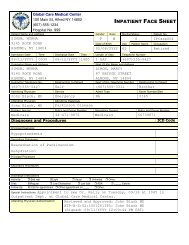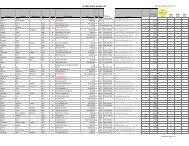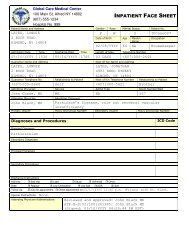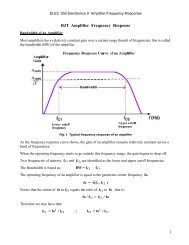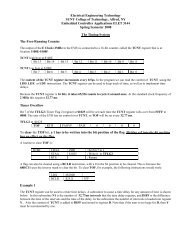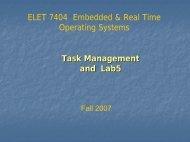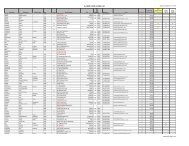RMA and Scheduling
RMA and Scheduling
RMA and Scheduling
Create successful ePaper yourself
Turn your PDF publications into a flip-book with our unique Google optimized e-Paper software.
ELET 7404 Embedded & Real TimeOperating SystemsRate Monotonic <strong>Scheduling</strong>Reference:Stewart, David <strong>and</strong> Michael Barr. "Rate Monotonic <strong>Scheduling</strong>“Embedded Systems Programming, March 2002, pp. 79-80.http://www.netrino.com/Publications/Glossary/<strong>RMA</strong>.phpFall 2007
Rate Monotonic <strong>Scheduling</strong>• The scheduling algorithm you choose depends on your goals.• Different algorithms yield different results.• Suppose you're given 10 jobs <strong>and</strong> each will take a day tofinish.• In ten days, you will have all of them done.• But what if one or more has a deadline ?• If the ninth task given to you has a deadline in three days,• Doing the tasks in the order you receive them will cause you tomiss that deadline
• The purpose of a real-time scheduling algorithm is toensure that critical timing constraints, such as deadlines<strong>and</strong> response time, are met.• Real-time scheduling is also used to allocate processortime between tasks in soft real-time embedded systems.• Many real-time systems use preemtive multitasking ,especially those with an underlying real-time operatingsystem (RTOS)• Priorities are assigned to tasks, <strong>and</strong> the RTOS alwaysexecutes the ready task with highest priority.
• The scheduling algorithm is the method in whichpriorities are assigned.• Most algorithms are classified as static priority,dynamic priority, or mixed priority.• A static-priority algorithm assigns all priorities atdesign time, <strong>and</strong> those priorities remain constant for thelifetime of the task.• A dynamic-priority algorithm assigns priorities atruntime, based on execution parameters of tasks, suchas upcoming deadlines.• A mixed-priority algorithm has both static <strong>and</strong>dynamic components.
Static-priority algorithms are simpler than algorithmsthat must compute priorities on the fly.The rate monotonic algorithm (<strong>RMA</strong>) is a procedure forassigning fixed priorities to tasks to maximize their"schedulability.“A task set is considered schedulable if all tasks meet alldeadlines all the time.The algorithm is:“Assign the priority of each task according to its period,so that the shorter the period the higher the priority”
• <strong>RMA</strong> is an optimal static-priority algorithm.• If a task set cannot be scheduled using the <strong>RMA</strong> algorithm,it cannot be scheduled using any static-priority algorithm• One major limitation of fixed-priority scheduling is that itis not always possible to fully utilize the CPU.• Even though <strong>RMA</strong> is the optimal fixed-priority scheme, ithas a worst-case schedule bound of:U = n [ 2 (1/n) –1 ]where n is the number of tasks in a system.
U = n [ 2 (1/n) –1 ]Note that the the worst-case schedulable bound for onetask is 100%.As the number of tasks increases, the schedulable bounddecreases, eventually approaching its limit of about69.3% (ln 2, to be precise).To probe this value ln 2, we need to recall l‘Hopital’s Rule
l‘Hopital’s Rule uses derivatives to help compute limitswith indeterminate forms.l’Hopital’s rule state that for function f(x) <strong>and</strong> g(x) ifthen:where the '‘denotes the derivative
GuidelinesTo benefit most from using a fixed-priority preemptive RTOS,consider the following rules of thumb:• Always assign priorities according to <strong>RMA</strong>.• If total utilization is less than or equal to U(n), all taskswill meet all deadlines, so no additional work needs to bedone.• If total utilization is greater than U(n), an analysis of thespecific task set is needed, to verify whether or not it willbe schedulable.• To achieve 100% utilization when using fixed priorities,assign periods so that all tasks are harmonic.
Guidelines (cont.)• Harmonic Tasks means that for each task, its period isan exact multiple of every other task that has a shorterperiod.• The last rule of thumb provides a simple guideline formost efficient use of the processor:For example, a three-task set whose periods are 10,20, <strong>and</strong> 40, respectively, is harmonic, <strong>and</strong> preferredover a task set with periods 10, 20, <strong>and</strong> 50.
Extended Rate Monotonic<strong>Scheduling</strong>
Extended Rate Monotonic <strong>Scheduling</strong>Now we have to consider blocking of resourcesdue to resource contentionC 1 /p 1 + … + C i /p i + B i /p i ≤ U(i) = i (2 1/i –1)1 ≤ i ≤ nB i = longest duration of blocking that can beexperienced by iC i = worse case execution time associated withperiodic task ip i = period associated with task in = number of tasks
Extended RMS: ExampleThe following diagram shows 3 tasks with their respective worse caseexecution times <strong>and</strong> periods. There are also two resources, with theirrespective duration for each task. Find the extended RMS equations foreach resource. Is there resource contention for this example ?. Explain.C 1 /p 1 + … + C i /p i + B i /p i ≤ U(i) = i ( 2 1/i –1)1 ≤ i ≤ n
Solution:• Resource1: this resource doesn’t have any issue sinceonly one task is using it.• Resource2: looking at its schedulability, yields threeseparate equations1.- For Task1: i = 1C 1 /p 1 + B 1 /p 1 = 20/100 + 18/100 = 0.38U(1) = 1 ( 2 1/1 –1) = 1It is true that 0.38 ≤ 1Therefore there is no resource contention for Resource2from Task1
2.- For Task2: i = 2C 1 /p 1 + C 2 /p 2 + B 2 /p 2 = 20/100 + 30/150 +18/150 = 0.52U(2) = 2 ( 2 1/2 – 1) = 0.8284It is true that 0.52 ≤ 0.8284Therefore there is no resource contention for Resource2from Task23.- For Task3: i = 3Because Task3 is low priority, Resource2 can always bepreempted by other task, therefore B 3 = 0C 1 /p 1 + C 2 /p 2 + C 3 /p 3 = 20/100 + 30/150 + 50/300 = 0.567U(3) = 3 ( 2 1/3 – 1) = 0.779It is true that 0.567 ≤ 0.779Therefore there is no resource contention for Resource 2from Task3
Dynamic Priority Algorithm
Dynamic Priority Algorithm• Dynamic Priority Algorithm• Earliest deadline first (EDF) scheduling• Example• Consider 3 periodic processes scheduled using EDF,the following acceptance test shows that alldeadlines will be met.• The theoretical limit for any number of processes is100% <strong>and</strong> so the system is schedulable.• e ii /p i ≤ 1ProcessExecutionTimePeriodP1 1 8P2 2 5P3 4 10
What happens if not scheduled properly• Problems:• Priority Inversion• Missed Deadlines• Deadlock
Priority Inversion• Unwanted software situation when high-priority task isdelayed while waiting for shared resource that is not in use• Priority inversion arises when a medium-priority taskpreempts lower priority task using a shared resource onwhich the higher priority task is pending• If higher priority task is otherwise ready to run, but amedium-priority task is currently running instead, a priorityinversion is said to occur
Deadline• Time at which a particular set of computations or datatransfers must be completed• Considered “Hard Deadline” if it ABSOLUTELY MUSTbe met every time• Hard Deadlines have serious consequences whenmissed• Other Deadlines are said to be “Soft Deadlines”
Deadlock• Entire set of tasks is blocked, waiting for an eventthat only a task within the same set can cause• Only solution is to reset the involved set of tasksor entire system• Usually possible to prevent deadlocks byfollowing certain software-design practices
Deadlock
Avoiding Deadlock• Acquire all resources before proceeding• Acquire resources in same order• Release all resources in reverse order• A timeout in a semaphore (provided by most kernels) canbe a way out of deadlock
Mutual ExclusionA shared resource is a resource that can be used bymore than one task.Each task should gain exclusive access to the sharedresource to prevent data corruption.This process is called Mutual ExclusionExist techniques that ensures the Mutual Exclusion
Mutual Exclusion (cont.)• Easiest way to communicate is through shareddata such as• Global variables• Pointers• Buffers• Linked lists• Ring buffers• However this could cause data corruption
Mutual Exclusion (cont.)• Sharing data simplifies exchange of information• Care must be take to ensure that each task has exclusiveaccess to the data to avoid contention <strong>and</strong> data corruption• Common 4 methods of gaining exclusive access toshared resources:1. Disabling interrupts2. Performing test-<strong>and</strong>-set operations3. Disabling scheduling, <strong>and</strong>4. Using semaphores
1. Disabling <strong>and</strong> enabling interrupts•Example• Disable interrupts• Access the resource (read/write from/ to variable)• Enable interruptsMicroC/OS-II provides macros for thisOS_ENTER_CRITICAL()OS_EXIT_CRITICAL()
Using μC/OS-II macros to disable <strong>and</strong>enable interruptsVoid Function (void){}OS_ENTER_CRITICAL();.. /* you can access shared data in here */.OS_EXIT_CRITICAL ();
2. Test-<strong>and</strong><strong>and</strong>-Set Operation• When using a kernel• Two functions could agree to access a resource• They check global variable for 0 to gain access• To prevent other function from accessing theresource, first function that reaches the resourcesets this variable to 1• This is referred to as test <strong>and</strong> set (TAS)
3. Disabling <strong>and</strong> Enabling the Scheduler(“Locking <strong>and</strong> Unlocking the Scheduler”)• If a task is not sharing variables or data structures with anISR, scheduling can be disabled <strong>and</strong> enabled• Using this method, two or more tasks can share datawithout contention• This method works very well, however should be avoidedbecause disabling the scheduler defeats the purpose ofhaving a kernel.A much better option is the use of SemaphoresISR - interrupt service routine
4. Semaphores• Key that your code acquires in order to continue execution• If semaphore already in use,the requesting task is suspended until the semaphore isreleased by its current owner• Two types of semaphores:• Binary• Can take only two values 0 or 1• Counting0 to 256 (8 bit)0 to 65,535 (16 bit)0 to 4,294,967,295 (32 bit)





